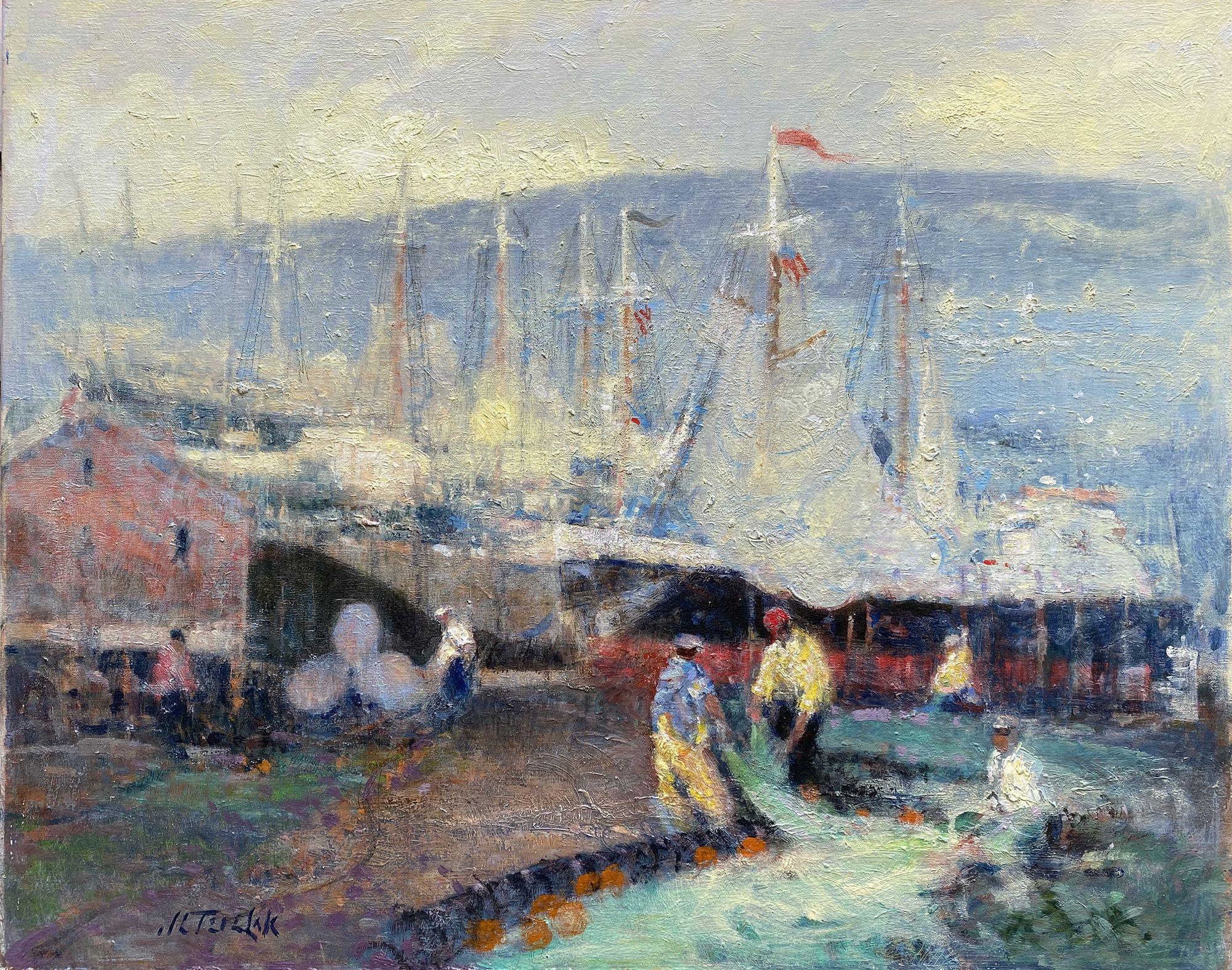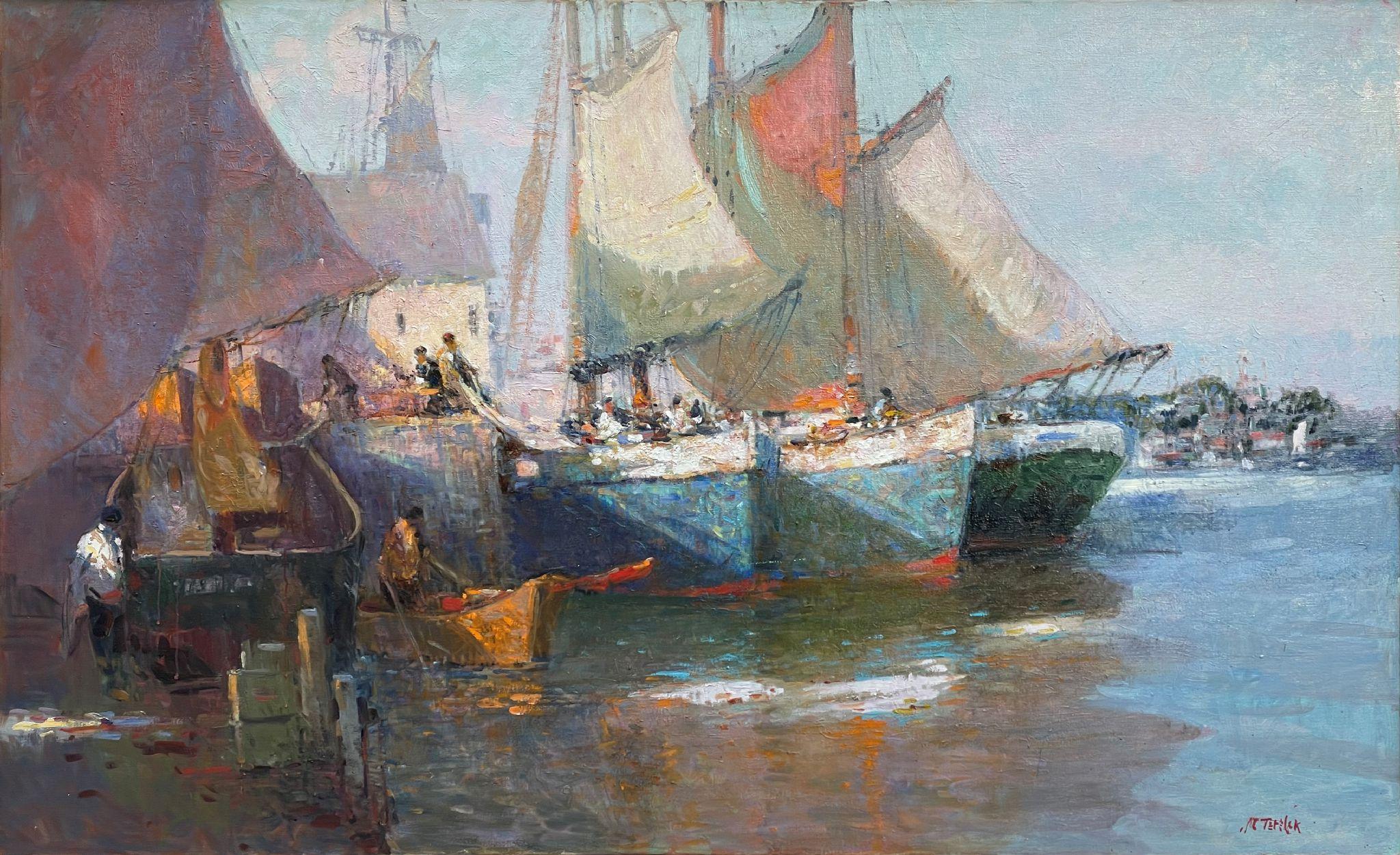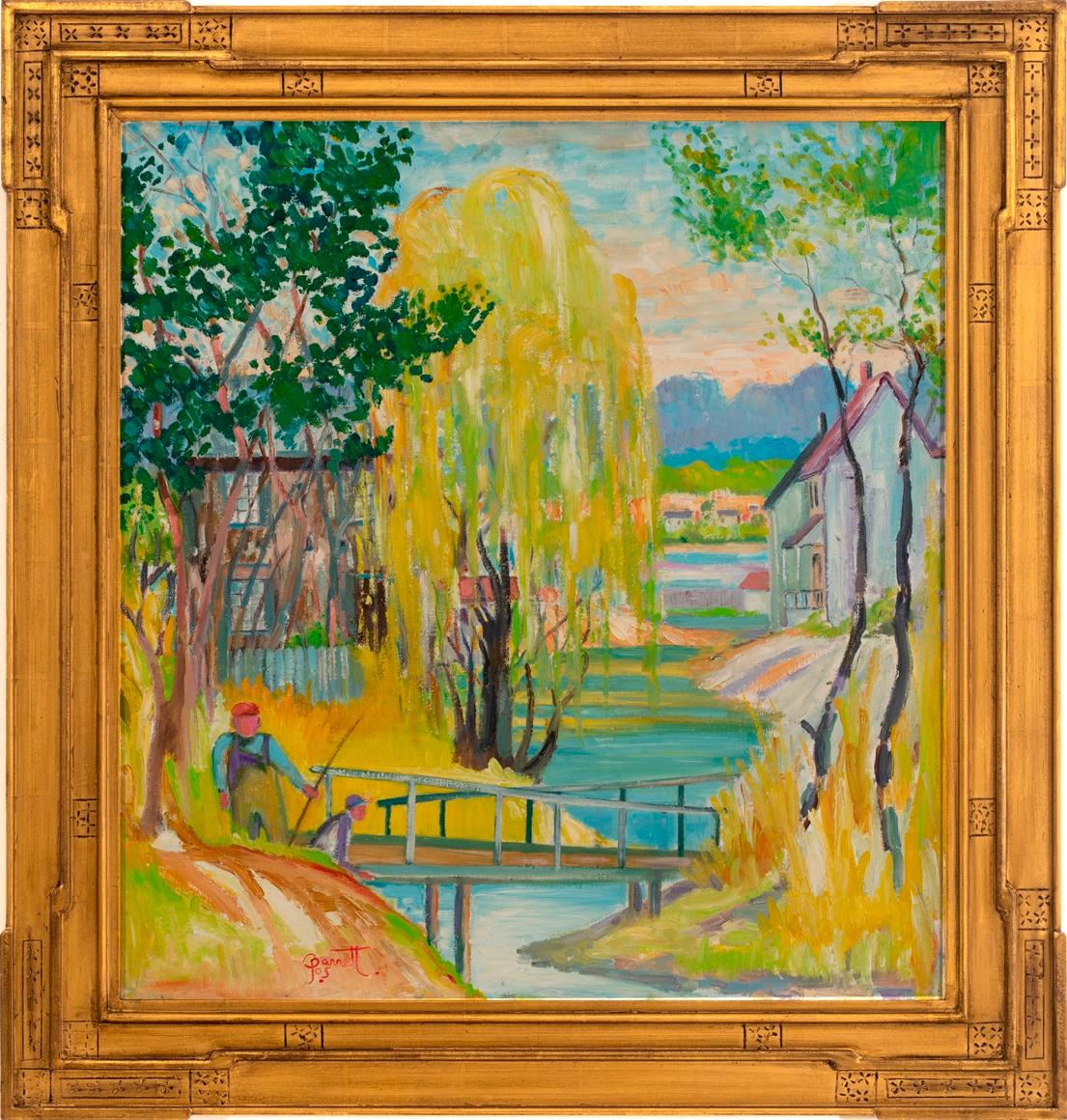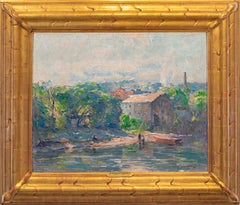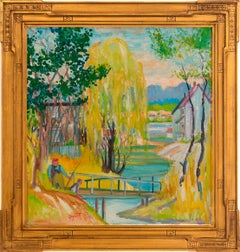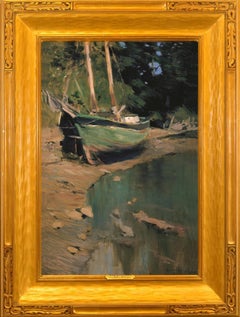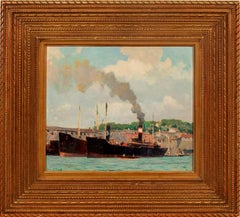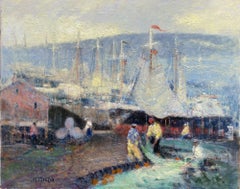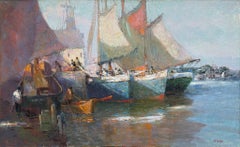Want more images or videos?
Request additional images or videos from the seller
1 of 6
John R. Grabach"Fresh Fish"c. 1935
c. 1935
$28,125
£21,225.16
€24,299.60
CA$39,665.58
A$43,547.85
CHF 22,719.01
MX$526,989.66
NOK 284,747.51
SEK 268,307.02
DKK 181,390.06
About the Item
Jim’s of Lambertville is proud to offer this artwork by:
John R. Grabach (1886 - 1981)
John Grabach was a highly regarded New Jersey artist, teacher, and author of the classic text, “How to Draw the Human Figure”. He was born in Massachusetts, and with his widowed mother, moved to Newark, New Jersey when he was eleven.
Starting out as a die-cutter for a silverware firm, Grabach also designed important works of sterling silver hollow ware and Art Deco glass designs for several high end retail manufacturers. He designed United States stamps for the Treasury Department and holiday greeting cards for several firms. Grabach enrolled in courses at the Art Students League in his spare time, studying under George Bridgeman, Frank Dumond, Kenyon Cox, and H. August Schwabe.
Considered a leading figure in the Newark School of Painters, his powerful Ashcan style paintings depicting scenes of New York City and Newark are truly American masterpieces. He captures the expressions and mood of his subjects in those complex compositions on par with any of the highly regarded Ashcan painters of the period. Similar in many ways to his contemporary, George Bellows, Grabach was gifted in portraying the everyday events of working class folks, and translating their ordinary daily routines into something extraordinary to look at.
Whether it be his native blue-collar Newark neighborhood, a crew of gruff dockworkers or something as regular and uninteresting as men eating soup, John Grabach had the ability to turn virtually any subject into appealing and worthy art.
From the 1920s through the 1960s, Grabach was the subject of numerous one-man exhibitions in prestigious galleries and institutions across the country. In 1980, the Smithsonian Institute in Washington, D.C., honored Grabach with a solo retrospective show of his work. This was an unusual tribute for a still living artist.
Grabach was a dedicated and beloved teacher at the Newark School of Industrial Design for many years and among his favorite students was Henry Gasser.
Grabach’s work is in the permanent collections of the Smithsonian, the Corcoran Gallery of Art, the Art Institute of Chicago, and the Philadelphia Art Alliance, among many others.
Source: New Hope for American Art, James Alterman
- Creator:John R. Grabach (1886 - 1981, American)
- Creation Year:c. 1935
- Dimensions:Height: 21 in (53.34 cm)Width: 25 in (63.5 cm)Depth: 2 in (5.08 cm)
- More Editions & Sizes:Framed Size 20" x 24"Price: $28,125
- Medium:
- Movement & Style:
- Period:
- Condition:
- Gallery Location:Lambertville, NJ
- Reference Number:Seller: LAM00121stDibs: LU3745451511
About the Seller
5.0
Vetted Professional Seller
Every seller passes strict standards for authenticity and reliability
Established in 1997
1stDibs seller since 2014
39 sales on 1stDibs
Typical response time: 1 to 2 days
- ShippingRetrieving quote...Shipping from: Lambertville, NJ
- Return Policy
Authenticity Guarantee
In the unlikely event there’s an issue with an item’s authenticity, contact us within 1 year for a full refund. DetailsMoney-Back Guarantee
If your item is not as described, is damaged in transit, or does not arrive, contact us within 7 days for a full refund. Details24-Hour Cancellation
You have a 24-hour grace period in which to reconsider your purchase, with no questions asked.Vetted Professional Sellers
Our world-class sellers must adhere to strict standards for service and quality, maintaining the integrity of our listings.Price-Match Guarantee
If you find that a seller listed the same item for a lower price elsewhere, we’ll match it.Trusted Global Delivery
Our best-in-class carrier network provides specialized shipping options worldwide, including custom delivery.More From This Seller
View All"Shad Fisherman"
By John Fulton Folinsbee
Located in Lambertville, NJ
Jim's of Lambertville Fine Art Gallery is proud to present this piece by John Fulton Folinsbee (1892 - 1972).
One of the finest painters to embark upon the New Hope Art Colony, John...
Category
1920s American Impressionist Landscape Paintings
Materials
Canvas, Oil
"Fishing on the Delaware"
By Joseph Barrett
Located in Lambertville, NJ
Illustrated in "Joseph Barrett, The Prime Years 1970s - 1990s", pg. 31, plate #035.
Jim’s of Lambertville is proud to offer this artwork by:
Joseph Barrett (1936 – )
Joseph B...
Category
Late 20th Century American Impressionist Landscape Paintings
Materials
Canvas, Oil
"Old Schooner"
By Henry Bayley Snell
Located in Lambertville, NJ
Jim’s of Lambertville is proud to offer this artwork.
Oil on canvas. Signed lower right. Complemented by a hand carved and gilt frame.
Illustrated in "New Hope for American Art" by James Alterman.
Henry Bayley Snell (1858 - 1943)
Henry Bayley Snell was born in Richmond, England, on September 29, 1858 and immigrated to the United States at the age of seventeen. He studied at the Art Students League in New York while working for an etching and engraving company where he began a lifelong friendship with fellow artists, William Langson Lathrop. While in New York Snell met another artist, named Florence Francis, also of English descent, whom he would eventually marry in 1888. It is believed that they first came to Bucks County in 1898 to visit the Lathrops at Phillips Mill.
Snell was a beloved teacher at the Philadelphia School of Design for Women from 1899 to 1943, and often took his art classes abroad during the summer. He would frequently visit his native England, spending time at the art colony of St. Ives on the coast of Cornwall. Snell would summer in Gloucester, Massachusetts, and Boothbay Harbor, Maine, where he also held painting classes. Almost all the women who exhibited with “The Philadelphia Ten” had studied with Snell either in Philadelphia or New England. Snell also taught on Saturdays at the Grand Central Galleries in New York City.
The Snells made many trips to New Hope before settling there permanently in 1925. They lived on the top floor of the Solebury National Bank Building where Henry also maintained a studio. This was located at the foot of the New Hope-Lambertville Bridge and many of Snell’s New Hope scenes were painted from this location. In 1943, Snell passed away in New Hope at the age of eighty-four.
Henry Snell earned an international reputation as an artist for his paintings of Cornwall...
Category
1920s American Impressionist Landscape Paintings
Materials
Canvas, Oil
"Steam Trawlers"
By Henry Bayley Snell
Located in Lambertville, NJ
Jim’s of Lambertville is proud to offer this artwork by:
Henry Bayley Snell (1858 - 1943)
Henry Bayley Snell was born in Richmond, England, on September 29, 1858 and immigrated to the United States at the age of seventeen. He studied at the Art Students League in New York while working for an etching and engraving company where he began a lifelong friendship with fellow artists, William Langson Lathrop. While in New York Snell met another artist, named Florence Francis, also of English descent, whom he would eventually marry in 1888. It is believed that they first came to Bucks County in 1898 to visit the Lathrops at Phillips Mill.
Snell was a beloved teacher at the Philadelphia School of Design for Women from 1899 to 1943, and often took his art classes abroad during the summer. He would frequently visit his native England, spending time at the art colony of St. Ives on the coast of Cornwall. Snell would summer in Gloucester, Massachusetts, and Boothbay Harbor, Maine, where he also held painting classes. Almost all the women who exhibited with “The Philadelphia Ten” had studied with Snell either in Philadelphia or New England. Snell also taught on Saturdays at the Grand Central Galleries in New York City.
The Snells made many trips to New Hope before settling there permanently in 1925. They lived on the top floor of the Solebury National Bank Building where Henry also maintained a studio. This was located at the foot of the New Hope-Lambertville Bridge and many of Snell’s New Hope scenes were painted from this location. In 1943, Snell passed away in New Hope at the age of eighty-four.
Henry Snell earned an international reputation as an artist for his paintings of Cornwall...
Category
20th Century American Impressionist Landscape Paintings
Materials
Oil, Board
"None Such Days"
By Joseph Barrett
Located in Lambertville, NJ
Illustrated in "Joseph Barrett, The Prime Years 1970s - 1990s", pg. 14 #016
Jim’s of Lambertville is proud to offer this artwork by:
Joseph Barrett (1936 – )
Joseph Barrett was born in Midland, North Carolina, in 1936 and studied at the Massachusetts College of Art in Boston and at the Tyler School of Art in Philadelphia. Barrett, now of Lahaska, Pennsylvania, has been painting his entire adult life. His favorite subjects include the landscape surrounding New Hope and many local landmarks often encompassing figures into his compositions. Barrett utilizes a heavy impasto and his palette bears similarities to that of Fern Coppedge and George Sotter. Barrett’s paintings are always found in unique and somewhat charming handmade frames designed by the artist and finished in metal leaf.
A living contemporary of the no longer living “New Hope School” impressionist painters, Joseph Barrett resides outside of New Hope above his old-fashioned antique shop and studio. Entering Barrett’s shop is like taking a step back in time. Inside this cluttered and dusty haven of treasures from the past, is a studio spanning only four by eight feet. This little studio, containing cans of old brushes and hundreds of used paint tubes...
Category
Late 20th Century American Impressionist Landscape Paintings
Materials
Canvas, Oil
"River Above New Hope"
By Joseph Barrett
Located in Lambertville, NJ
Illustrated in "Joseph Barrett, The Prime Years 1970s - 1990s", pg. 41, plate #047
Jim’s of Lambertville is proud to offer this artwork by:
Joseph Barrett (1936 – )
Joseph Barrett was born in Midland, North Carolina, in 1936 and studied at the Massachusetts College of Art in Boston and at the Tyler School of Art in Philadelphia. Barrett, now of Lahaska, Pennsylvania, has been painting his entire adult life. His favorite subjects include the landscape surrounding New Hope and many local landmarks often encompassing figures into his compositions. Barrett utilizes a heavy impasto and his palette bears similarities to that of Fern Coppedge and George Sotter. Barrett’s paintings are always found in unique and somewhat charming handmade frames designed by the artist and finished in metal leaf.
A living contemporary of the no longer living “New Hope School” impressionist painters, Joseph Barrett resides outside of New Hope above his old-fashioned antique shop and studio. Entering Barrett’s shop is like taking a step back in time. Inside this cluttered and dusty haven of treasures from the past, is a studio spanning only four by eight feet. This little studio, containing cans of old brushes and hundreds of used paint tubes...
Category
Late 20th Century American Impressionist Landscape Paintings
Materials
Canvas, Oil
You May Also Like
Lobster Fishermen
Located in San Francisco, CA
This artwork titled "Lobster Fishermen" c.1945, is an oil painting on canvas by renown American impressionist artist Claude Curry Bohm, 1894-1971. It is signed at the lower left corner by the artist. The canvas size is 20 x 24 inches, framed size is 26.25 x 30.25 inches. Framed in a new wooden gold leaf plein air style frame. It is in excellent condition, it has been recently revarnish and new keys have been added to the canvas stretcher. Please note the the dark line on the top and left side of the painting are only the shadow, it is not a part of this artwork.
About the artist:
Claude Curry Bohm, a photographer, painter, and printmaker whose artistic career spanned five decades, was an integral part of the Chicago art scene in the 1920s and a very prominent part of the second generation of the Brown County...
Category
Mid-20th Century American Impressionist Figurative Paintings
Materials
Oil
Fishermen
By John Terelak
Located in Greenwich, CT
American, b. 1942
John Charles Terelak is recognized as one of America's finest living impressionists. Born in Boston, Massachusetts, he received formal art instruction at the Vespe...
Category
2010s American Impressionist Figurative Paintings
Materials
Canvas, Oil
Making Ready
By John C. Terelak
Located in Greenwich, CT
American, b. 1942
John Charles Terelak is recognized as one of America's finest living impressionists. Born in Boston, Massachusetts, he received formal art instruction at the Vespe...
Category
2010s American Impressionist Landscape Paintings
Materials
Canvas, Oil
Salmon Fishing
By John Whorf
Located in Milford, NH
A fine impressionist sporting painting with salmon fisherman in a canoe by American artist John Whorf (1903-1959). Whorf was born in Winthrop, Massachusetts and by the age of sixteen...
Category
Mid-20th Century American Impressionist Landscape Paintings
Materials
Canvas, Oil
$22,000
Cripple Cove
By John Terelak
Located in Greenwich, CT
American, b. 1942
John Charles Terelak is recognized as one of America's finest living impressionists. Born in Boston, Massachusetts, he received formal art instruction at the Vesper George School of Fine Art. Terelak's love of paint and canvas and his thorough understanding of color theory and paint technique eventually led him to become Headmaster of the Gloucester Academy of Fine Art. As demand for his work grew, it eventually became necessary for John to devote his full energies to the creation of his own paintings. Since making that decision he has enjoyed outstanding and continuing success in his career. His professional career at the easel now spans more than three decades. In addition to his beautiful work in oil, Terelak is also a master in watercolor and pastel. He is also a past President of The New England Watercolor...
Category
2010s American Impressionist Landscape Paintings
Materials
Canvas, Oil
Uncle Dick's Fish House
By William Lester Stevens
Located in Saratoga Springs, NY
Signed lower right
Bio:
Born in Rockport, Massachusetts, Stevens received his initial art training from Parker Perkins, a local marine painter who charged him fifty cents an hour. He later spent four years at Boston's Museum of Fine Arts School, where he studied under Edmund Tarbell, among others. Although influenced by Tarbell, Stevens' wide range of brushstrokes and impressionist style prevented him from being classified as a "Tarbellist," as many of Tarbell's followers were labeled.
Stevens joined the Army in 1917 and was sent to Europe where he continued to paint and sketch. Upon his return to the United States, he was pleased to discover that Rockport had become a popular haven for artists. Though he was the only native son among them, such well-known painters as Frank Duveneck, Childe Hassam, Leon Kroll and Jonas Lie also recorded the scenery of Rockport, Cape Ann and Gloucester.
In 1921, together with fifty other artists, Stevens founded the Rockport Art Association, primarily to plan exhibitions of the work of outstanding area artists.
Throughout the course of his long career, Stevens taught, first in Rockport, then at Boston University (1925-1926) and Princeton (1927-1929). He later gave lessons and held one-man shows in Charlotte and Asheville, North Carolina, where his work was well-received. Southerners particularly enjoyed his views of famous Southern gardens and cities.
Though the Depression years were difficult for both the artist and his family, the 1930s did bring Stevens some measure of commercial and personal success. He did a number of covers for "The American Legion Magazine" and won prizes in New Haven, Springfield and Rockport. In 1934, he abandoned Rockport to the growing tourist population and moved to Springfield, and then to Conway, Massachusetts, where he remodeled an old farmhouse and constructed a studio which looked north towards Mount Monadnock...
Category
Mid-20th Century Impressionist Landscape Paintings
Materials
Canvas, Oil
More Ways To Browse
Vintage Fish Art
American Masterpiece
Joseph Nechvatal
Kent Sullivan Paintings
Kentucky Painting
Lake Como Oil Painting
Lake George Oil Painting
Lake Louise
Leon Lhermitte
Loch Lomond Art
M Church
Maine Seascape Paintings
Michael Miller Art
Miles Impressionist
Modern Paintings Palm Trees
Montparnasse Picture Frame
Mountain Man Art
Oil Painting Aspen Tree
